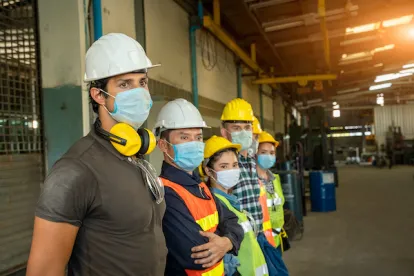On December 22, 2021, the New York State Department of Labor (“NYDOL”) issued a proposed rule regarding workplace safety committees under the HERO Act. As we have previously reported, the HERO Act requires all employers in New York State to adopt a prevention plan to protect against the spread of COVID-19 and other airborne infectious diseases in the workplace. Section 2 of the Act also requires employers with at least 10 employees to allow employees to “establish and administer a join labor-management workplace safety committee.” A summary of the proposed rule regarding Section 2 of the Act is provided below.
Establishing a Workplace Safety Committee
While there is no affirmative obligation for employers to create a workplace safety committee, covered employers must allow employees to create a committee upon request. According to the proposed rule, the request must be made in writing by at least two non-supervisory employees at the worksite. Multiple requests for committee recognition by one or more non-supervisory employees must be combined and treated as a single request. Requests for committee recognition received after a committee has been recognized must be denied and referred to the existing committee.
According to the proposed rule, employers must respond to recognition requests “with reasonable promptness.” Once the employer recognizes the workplace safety committee, the employer must provide notice to all employees at the worksite within five days of recognition.
Workplace safety committees may be established separately for each worksite. However, employees may also form a committee that represents two or more worksites operated by the same employer, including by employees who work at multiple worksites.
Committee Composition Requirements
According to the proposed rule, workplace safety committees must be composed of at least two non-supervisory employees and an employer representative and be co-chaired by a non-supervisory employee and an employer representative. Workplace safety committees must have at most 12 members or one-third of the total number of employees at the worksite, whichever is fewer. Worksites with fewer than 10 employees must have exactly three representatives. Regardless of the committee’s size, there must be at least two non-supervisory employees for every employer representative.
Employers may not interfere with the selection of non-supervisory employee committee members. Worksites without a collective bargaining agreement must select non-supervisory committee representatives through a method chosen by the non-supervisory employees. Non-supervisory committee representatives at worksites with collective bargaining agreements are chosen by the collective bargaining representative and may include both union and non-union employees.
Committee Rulemaking Procedure
Under the proposed rule, workplace safety committees may establish rules or bylaws to govern how the committee operates. Any established rule or bylaw must be consistent with section 27-D of the New York Labor Law. Such rules and bylaws may include the selection of new members, term length, and the training of new members. Committees may take action in accordance with any such rules or procedures adopted by the committee. If no procedures or rules are adopted, the committee may take action by a majority vote.
Committee Meeting Requirements
The proposed rule provides that workplace safety committee meetings may be conducted at least once per quarter for no longer than two work hours during paid work time. Additional meetings may be held, but cannot be scheduled during work hours. Employees are also not entitled to compensation for their participation in any additional meetings unless previously agreed to by the employer.
Meetings must be scheduled in accordance with rules adopted by the committee or, if no relevant rules exist, by agreement of the committee co-chairs. Meetings must be scheduled at times that do not unreasonably conflict with the employer’s business.
Workplace safety committees may provide an official training for members, provided that the training does not exceed four hours in any calendar year. Committee members must be paid for any such training time.
Employer Obligations
Additional employer obligations under the proposed rule include:
-
Appointing an employer representative to the committee to act as a co-chair. Such employer representative may be a non-supervisory employee, an officer, the employer, or other representative.
-
Responding in writing to each concern raised by the workplace safety committee or by one of its members within a reasonable time period.
-
Responding to a request for policies or reports that relate to the duties of the workplace safety committee within a reasonable time period.
-
Providing notice when practicable and not prohibited by law to the workplace safety committee and its members ahead of any visit at the worksite by a governmental agency enforcing safety and health standards.
-
Refraining from interfering with the performance of the duties of the workplace safety committee or its members.
Employers do not need to disclose information or documentation to the workplace safety committee or to a committee member when such a disclosure is prohibited by law, contains personal identifying information of an employee as defined by section 203-d of the New York Labor Law or is outside the scope of information required by section 27-d(4) of the New York Labor Law.
A public hearing on the proposed rule will be held on February 9, 2022, and public comments will be accepted by the NYDOL until five days after the last scheduled public hearing.
We will continue to monitor developments with regard to this proposed rule and the HERO Act more generally.





 />i
/>i

